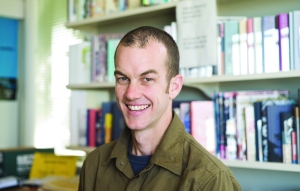 When I opened The Exercise Book I went straight to Gavin McGibbon’s ‘Famous Person’ exercise. There were two reasons for this: firstly, Gavin’s thinking on story has had a strong influence on my work, not so much through direct advice but more through the atmosphere of story nous that seems to surround scriptwriters from the IIML. Secondly, I was attracted to the title of this exercise because many of my stories touch on—trade on, mess with and manipulate—famous people and famous lives.
When I opened The Exercise Book I went straight to Gavin McGibbon’s ‘Famous Person’ exercise. There were two reasons for this: firstly, Gavin’s thinking on story has had a strong influence on my work, not so much through direct advice but more through the atmosphere of story nous that seems to surround scriptwriters from the IIML. Secondly, I was attracted to the title of this exercise because many of my stories touch on—trade on, mess with and manipulate—famous people and famous lives.
The exercise involves taking a famous person and having them fall into or opt for a very different way of life—Albert Einstein becomes a boxer, John Key joins a gang. Without forcing some easy transition, the writer has to tell the story of this ‘gigantic change’, in such a way that it seems convincing and natural, and we believe it every step of the way.
The final step is to scratch out the name of the famous person and substitute another, made-up name, this new person becoming the protagonist of your story, script, or novel.
This appeals to me because it forces the character to go on a journey that takes them far, far away from their existing sense of themselves. As they leave their comfort zone, the character is forced to ask themselves: Who am I? How do I become my opposite?
This is a recipe for BIG story ideas, because it’s forcing the deepest kind of character analysis and character change. It’s asking the character to leave the place where they know everything, and step into the borderland where they know nothing. You can’t help but generate big stories out of that journey.
And perhaps I’m attracted to the test that is posed in this exercise because it’s analogous to a test that I often ask of the famous people who populate my stories: What is this character’s worst nightmare? What happens when he or she is forced to confront it?
I find that when my stories don’t have a clear vision of this nightmare, and the character’s journey towards it, the character and their motivations remain foggy, the central conflicts never arrive, and the story quickly dies on the page. In this graveyard lie many good ideas for stories about famous people (well, I thought they were good at the time): Billy Corgan wakes up in an Ashburton apple-orchard; Norm Kirk is kidnapped by students.
These seemed to be cute ideas for stories, but never got beyond that territory of idea to becoming a testing problem for characters. It would not be a nightmare for Norm Kirk to be kidnapped by students (they probably all voted for him in the first place!), and Billy Corgan’s ‘poetic’ ego would probably cope quite well with semi-rural solitude, using the time to write yet more anguished lyrics about the toe-staring grunge-rock lifestyle. These characters have not been forced to go through Gavin’s ‘gigantic change’, so we remain trapped in our existing understanding about them. Norm Kirk is friendly with young folk from the left—who knew?! Billy Corgan (creatively) mopes a lot? Ditto. No new and previously unknown aspect of the famous person’s character is brought into the light. There is no cataclysmic change, no nightmare, and no story.
Conversely, when characters can articulate that nightmare and come face to face with it, they can begin to deal with it, and by the time they have finished doing that, they’ve often changed considerably, or perceived a need to change. Not quite into their opposite, perhaps, but at least into someone who can glimpse that other—opposite—version of themselves.
Lawrence Patchett’s first story collection, I Got his Blood on Me: Frontier Tales is published by VUP and will be launched by Laurence Fearnley at Unity Books, Wellington on Thursday 7 June, 6pm.
